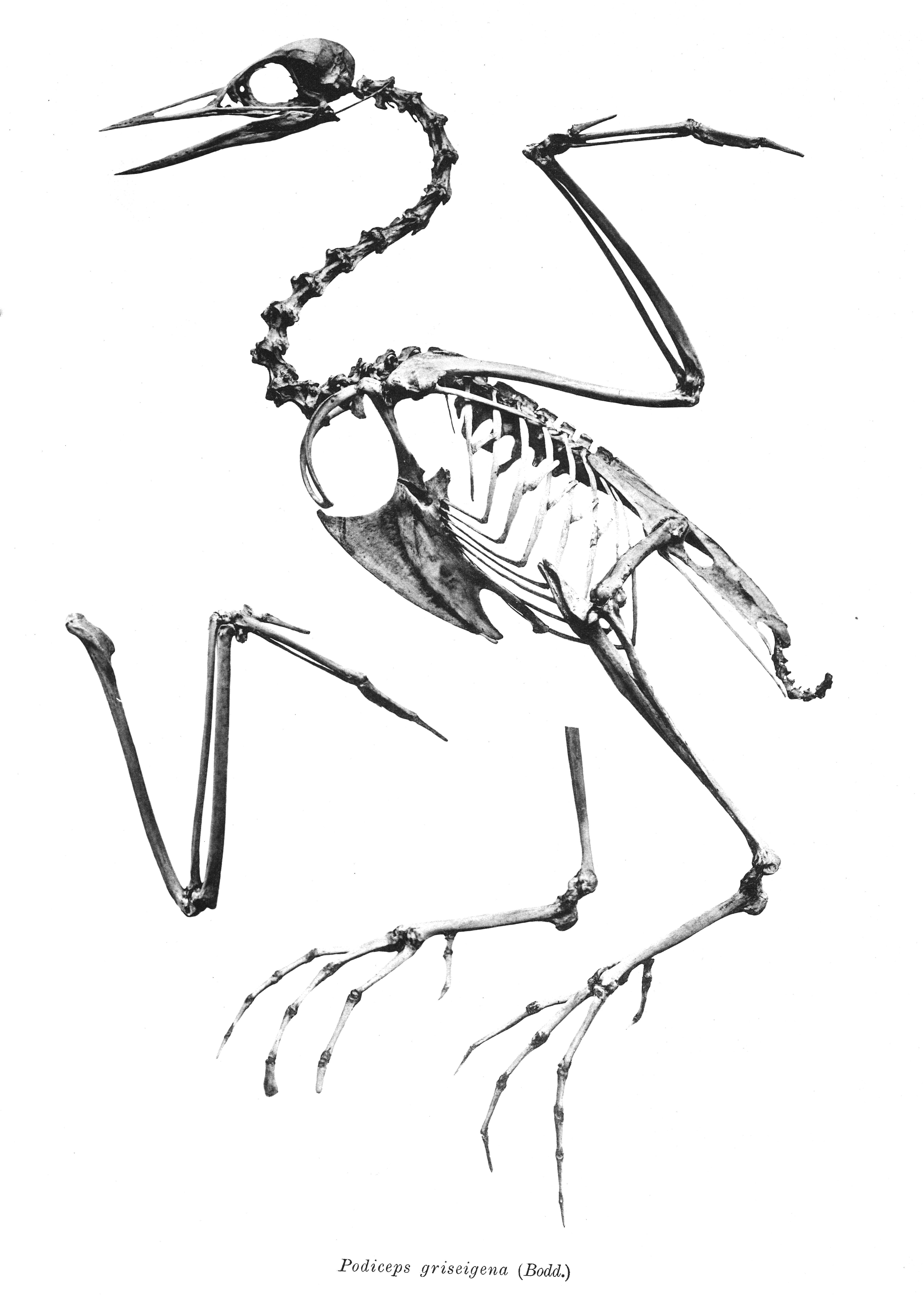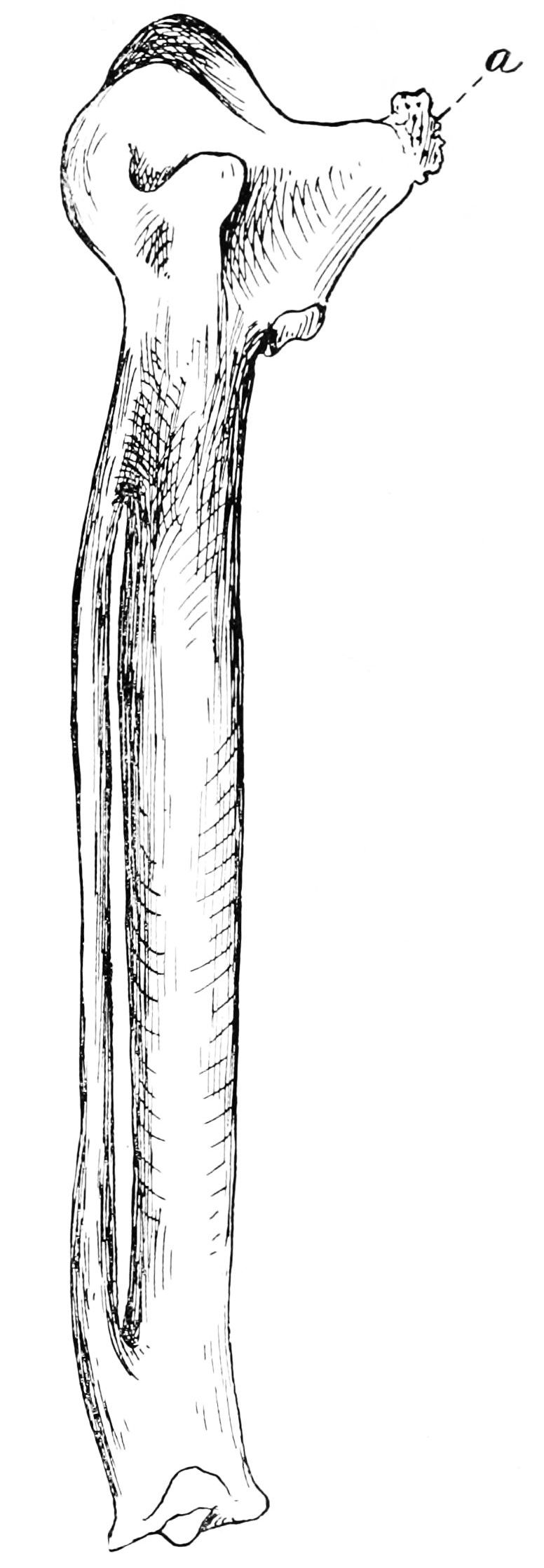|
Podiceps Dixi
''Podiceps dixi'' is a possible extinct species of grebe from the United States. History ''P. dixi'' was part of 5000 bird fossils that were cataloged from Reddick, Marion County, Florida. The material was collected by H. James Gut in 1950 and the species was described by the American ornithologist and paleontologist Pierce Brodkorb in 1963. The species name "dixi" is named after the Dixie Lime Products Company where they had a mine located at the Reddick beds where the fossil was found. Description The holotype and only specimen (UF/PB 1113) is of a proximal end of the right carpometacarpus. It is similar to the living horned grebe (''P. auritus'') but somewhat larger. Classification Due to the overall similarity of the bone to those of horned grebes, as well as the fragmentary nature of it, some authors have question the validity of the species suggesting that the name be a junior synonym of ''P. auritus''. Paleobiology The age of the ''P. dixi'' limb element is that of the ... [...More Info...] [...Related Items...] OR: [Wikipedia] [Google] [Baidu] |
Pierce Brodkorb
William Pierce Brodkorb (September 29, 1908, Chicago – July 18, 1992, Gainesville, Florida) was an American ornithologist and paleontologist. Interested in birds since childhood, he was taught to prepare birds at the age of 16. Later, he received the opportunity to work as a staff technician in the Ornithology Division of the Field Museum. He entered the University of Michigan in 1933 and obtained his PhD degree in 1936. Subsequently, he became an assistant curator of birds at the Museum of Zoology in Michigan until 1946. In 1946, he accepted a professorate in the Department of Zoology at the University of Florida in Gainesville, a position he held until his retirement in 1989. His doctoral students include Glen E. Woolfenden. From the 1950s, Brodkorb built up a huge collection of bird fossils from the Miocene, the Pliocene, and the Pleistocene of Florida, which included 12,500 skeletons from 129 families, and is on display at the Florida Museum of Natural History, part ... [...More Info...] [...Related Items...] OR: [Wikipedia] [Google] [Baidu] |
Grebe
Grebes () are aquatic diving birds in the order (biology), order Podicipediformes (). Grebes are widely distributed freshwater birds, with some species also found in sea, marine habitats during Bird migration, migration and winter. Most grebes fly, although some flightless species exist, most notably in stable lakes. The order contains a single family (biology), family, the Podicipedidae, which includes 22 species in six extant genus, genera. Although, superficially, they resemble other diving birds such as loons and coots, they are most closely related to flamingos, as supported by morphology (biology), morphological, molecular and paleontology, paleontological data. Many species are monogamy in animals, monogamous and are known for their courtship displays, with the pair performing synchronized dances across the water's surface. The birds build floating vegetative nests where they lay several eggs. About a third of the world's grebes are listed at various levels of conservatio ... [...More Info...] [...Related Items...] OR: [Wikipedia] [Google] [Baidu] |
Marion County, Florida
Marion County is a county located in the North Central region of the U.S. state of Florida. As of the 2020 United States census, the population was 375,908. Its county seat is Ocala. Marion County comprises the Ocala, Florida Metropolitan Statistical Area. It includes part of Ocala National Forest, which also extends into three other counties. History Native Americans Evidence of ancient indigenous cultures has been found in Marion County, as well as of the earliest encounter between European explorers and historic indigenous peoples. In 1976, an archaeological investigation found ancient artifacts in Marion County that appear to be the oldest in mainland United States. Excavations at an ancient stone quarry (on the Container Corporation of America site (8Mf154) in Marion County) yielded "crude stone implements". Thousands of pieces of chert were found at the site. These showed signs of extensive wear and were found in deposits below those holding Paleo-Indian artifacts. The ... [...More Info...] [...Related Items...] OR: [Wikipedia] [Google] [Baidu] |
Ornithologist
Ornithology, from Ancient Greek ὄρνις (''órnis''), meaning "bird", and -logy from λόγος (''lógos''), meaning "study", is a branch of zoology dedicated to the study of birds. Several aspects of ornithology differ from related disciplines, due partly to the high visibility and the aesthetic appeal of birds. It has also been an area with a large contribution made by amateurs in terms of time, resources, and financial support. Studies on birds have helped develop key concepts in biology including evolution, behaviour and ecology such as the definition of species, the process of speciation, instinct, learning, ecological niches, guilds, insular biogeography, phylogeography, and conservation. While early ornithology was principally concerned with descriptions and distributions of species, ornithologists today seek answers to very specific questions, often using birds as models to test hypotheses or predictions based on theories. Most modern biological theories apply ... [...More Info...] [...Related Items...] OR: [Wikipedia] [Google] [Baidu] |
Paleontologist
Paleontology, also spelled as palaeontology or palæontology, is the scientific study of the life of the past, mainly but not exclusively through the study of fossils. Paleontologists use fossils as a means to classify organisms, measure geologic time, and assess the interactions between prehistoric organisms and their natural environment. While paleontological observations are known from at least the 6th century BC, the foundation of paleontology as a science dates back to the work of Georges Cuvier in 1796. Cuvier demonstrated evidence for the concept of extinction and how life of the past was not necessarily the same as that of the present. The field developed rapidly over the course of the following decades, and the French word ''paléontologie'' was introduced for the study in 1822, which was derived from the Ancient Greek word for "ancient" and words describing relatedness and a field of study. Further advances in the field accompanied the work of Charles Darwin who popu ... [...More Info...] [...Related Items...] OR: [Wikipedia] [Google] [Baidu] |
Carpometacarpus
The carpometacarpus is a bone found in the hands of birds. It results from the fusion of the carpal and metacarpal bone, and is essentially a single fused bone between the wrist and the knuckles. It is a smallish bone in most birds, generally flattened and with a large hole in the middle. In flightless birds, however, its shape may be slightly different, or it might be absent entirely. It forms the tip of the wing skeleton in birds. To it, most of the primary remiges attach. The alula, by contrast, is formed by the thumb, which does not completely fuse with the other hand-bones. Likewise, the tipmost primaries attach to the phalanx bone The phalanges (: phalanx ) are digital bones in the hands and feet of most vertebrates. In primates, the thumbs and big toes have two phalanges while the other digits have three phalanges. The phalanges are classed as long bones. Structu ...s. To non- biologists the carpometacarpus may be best known from buffalo wings. Buffalo wings ... [...More Info...] [...Related Items...] OR: [Wikipedia] [Google] [Baidu] |
Horned Grebe
The horned grebe or Slavonian grebe (''Podiceps auritus'') is a relatively small and Threatened species, threatened species of waterbird in the family Podicipedidae. There are two subspecies, ''P. a. auritus'' (Slavonian grebe), which breeds in Eurasia, and ''P. a. cornutus'' (horned grebe), which breeds in North America. The Eurasian subspecies is distributed over most of northern Europe and northern Asia, breeding from Iceland east to the Russian Far East. The North American subspecies spans most of Canada and some of the United States. A small population was cited in Greenland in 1973, but is not mapped or further mentioned by subsequent authors. The American name 'horned' refers to the orange-yellow crest feathers located above and behind the eyes, called "horns". The English name, originally 'Sclavonian', is first attested by George Montagu (naturalist), George Montagu in his 1802 ''Ornithological Dictionary'', from ''Sclavonia (other), Sclavonia'', an old ... [...More Info...] [...Related Items...] OR: [Wikipedia] [Google] [Baidu] |
Rancholabrean
The Rancholabrean North American Land Mammal Age on the geologic timescale is a North American faunal stage in the North American Land Mammal Ages chronology (NALMA),Sanders, A.E., R.E. Weems, and L.B. Albright III (2009) Formalization of the mid-Pleistocene "Ten Mile Hill beds" in South Carolina with evidence for placement of the Irvingtonian–Rancholabrean boundary, ''Museum of Northern Arizona Bulletin'' 64:369-375 named after the famed Rancho La Brea fossil site (more commonly known as the La Brea tar pits) in Los Angeles, California.Savage, D.E. (1951) Late Cenozoic vertebrates of the San Francisco Bay region, ''University of California Publications, Bulletin of the Department of Geological Sciences'' 28:215-314 The Rancholabrean is characterized by the presence of the genus ''Bison,'' which appeared in northwestern North America during the Illinoian (globally known as the Penultimate Glacial Period or Marine Isotope Stage 6) around 190-130,000 years ago, before becoming es ... [...More Info...] [...Related Items...] OR: [Wikipedia] [Google] [Baidu] |
Podiceps
''Podiceps'' is a genus of birds in the grebe family. The genus name comes from Latin , "rear-end" and ', "foot", and is a reference to the placement of a grebe's legs towards the rear of its body. It has representatives breeding in all continents except Antarctica. Some species are partially or entirely migratory, moving in winter to the coast or warmer climates. Most species are widespread and overall common, but three South American species each are restricted to a single country; two of them are seriously threatened and a third is already extinct. They breed in vegetated areas of freshwater lakes, nesting on the water's edge, since their legs are set too far back for easy walking. Usually two eggs are laid, and the striped young may be carried on the adult's back. All the genus are excellent swimmers and divers, and pursue their fish prey underwater. Adults have striking breeding plumage, with no difference between the sexes. In winter, the plumage is subdued whites and gr ... [...More Info...] [...Related Items...] OR: [Wikipedia] [Google] [Baidu] |
Fossil Taxa Described In 1963
A fossil (from Classical Latin , ) is any preserved remains, impression, or trace of any once-living thing from a past geological age. Examples include bones, shells, exoskeletons, stone imprints of animals or microbes, objects preserved in amber, hair, petrified wood and DNA remnants. The totality of fossils is known as the ''fossil record''. Though the fossil record is incomplete, numerous studies have demonstrated that there is enough information available to give a good understanding of the pattern of diversification of life on Earth. In addition, the record can predict and fill gaps such as the discovery of ''Tiktaalik'' in the arctic of Canada. Paleontology includes the study of fossils: their age, method of formation, and evolutionary significance. Specimens are sometimes considered to be fossils if they are over 10,000 years old. The oldest fossils are around 3.48 billion years to 4.1 billion years old. Early edition, published online before print. The ob ... [...More Info...] [...Related Items...] OR: [Wikipedia] [Google] [Baidu] |






